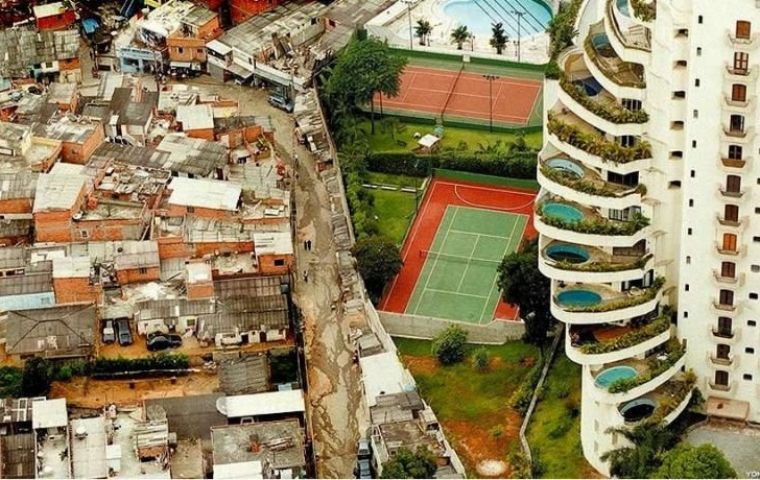MercoPress. South Atlantic News Agency
Brazil despite its economic success remains one of the inequality champions
 The ‘favelas’ or shanty towns that surround most Brazilian cities
The ‘favelas’ or shanty towns that surround most Brazilian cities Brazil might be the leading economy in Latin America and has had a significant performance in reducing poverty in recent years, but it still remains among the countries with he highest inequality in the region together with Guatemala, Honduras and Colombia, points out the UN-Habitar report.
In all four countries based on 2009 data, the GINI income per capita distribution index stood at 0.56, to which must be added Dominican Republic and Bolivia, two inequality champions with high concentration of wealth.
This compares with the US and Portugal GINI indicator of 0.38, two countries that offer no relief since Portugal for example has the highest inequality index of the European Union.
Nevertheless Brazil advanced compared to 1990 when it had the highest degree of inequality and stood well ahead from the rest of the continent. But the region continues to have the highest inequality rate in spite of advances in helping income distribution.
Among some of the causes for distribution improvement are productivity, upward trend of salaries and workers categories, strong economy and implementation of income transfer problems in several countries, particularly in the two leading economies, Brazil and Mexico. In the case of Brazil, the country’s economy now figures sixth at global level.
Former president Lula da Silva and one of the most popular leaders in history of that country based his success precisely on the Plan Boursa, which distributed a monthly basic food basket to millions, helping anywhere from 14 to 22 million climb out of poverty, plus ensuring his Workers Party an encouraging future.
The Gini coefficient or index measures the inequality among values of a frequency distribution (for example levels of income). A Gini coefficient of zero expresses perfect equality where all values are the same (for example, where everyone has an exactly equal income). A Gini coefficient of one (100 on the percentile scale) expresses maximal inequality among values (for example where only one person has all the income).




Top Comments
Disclaimer & comment rules-

-

-

Read all commentsThat photo is really shocking. Lets build a big wall and pretend the poor people don't exist!
Aug 22nd, 2012 - 07:49 am 0Do Brazil seriously think they should be a member of the UN security council, when most of their people live like that?
So giving 12 USD a month to a brazilian family mean rescuing them out of poverty? Lula and PT´s created propaganda out of a social program. Mexico has Oportunidades since 2002, a similar program, the first of its kind in the world, that gives cash transfers to poor people, but none has ever claimed that the program rescuing them out of poverty. Families earning 50 USD a month, and getting a 12 or 24 USD cash transfer from the state are still poor, and dependant from the state.
Aug 22nd, 2012 - 11:06 am 0Economic stability, low inflation, low interest rates, a stable currency, access to education, labor flexibility, free trade and antimonopoly regulations is what lifts people out of poverty, no cash transfer will do that, they only create clientelism, corruption and dependency.
Steve
Aug 22nd, 2012 - 02:39 pm 0It is shocking, but if you lived there you would probably want to be on the right side of the wall. In developing countries you often find 3rd world and 1st world living along side each other. It is not an easy process and there is no quick fix.
JAdeM: I fully agree with you. This is basically the Chilean approach. You also need strong institutions otherwise you are building on sand.
Commenting for this story is now closed.
If you have a Facebook account, become a fan and comment on our Facebook Page!